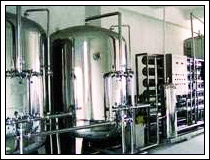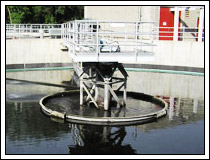Processing of Drinking Water
Whether drawn from a well or processed in an advanced water treatment plant, drinking water may contain pollutants and unwanted particles like runoff from agriculture, pesticides used in farming, as well as harmful microbial organisms bacteria and cysts. With the ever increasing rise in pollution levels in today's world  there is an urgent need for water treatment techniques through which the contaminated water can be purified and treated of its pollutants & waste and used or safely returned to the environment. There are numerous methods adopted for treating water, a few of which are discussed below: there is an urgent need for water treatment techniques through which the contaminated water can be purified and treated of its pollutants & waste and used or safely returned to the environment. There are numerous methods adopted for treating water, a few of which are discussed below:
Common Types of Drinking Water Processing Treatment
Flocculation/Sedimentation
Flocculation or floculation is a significant process widely utilized in water treatment operations, including purification of drinking water. Though often used interchangeably with coagulation, it is in fact a distinct process that similar to coagulation aids in sediment and contaminant transport. Usually, flocculation follows the coagulation process and helps in getting rid of of colloidal particles or flocs through rapid settlement in the solution. In certain cases, flocks also rise to the surface of the treated liquid, which can then be filtered out from the solution through the process of filtration. Alum and iron salts or synthetic organic polymers (used alone or in combination with metal salts) are used to promote coagulation or flocculation of contaminated water.
Disinfection
One of the most viable of primary water processing techniques designed for destructing and inactivating pathogenic organisms or microbes in a sample like domestic wastewater is disinfection. It works by minimizing or impeding the spread of waterborne diseases to downstream users and the environment. Harmful organisms that usually thrive in water are pathogenic enteric bacteria, viruses, helminthes and their eggs, and protozoan cysts – all of which are bearers of many dangerous waterborne diseases such as typhoid and paratyphoid fever, cholera, bacillary dysentery, giardiasis, crytosporidiosis, amoebic dysentery, poliomyelitis, infectious hepatitis, aseptic meningitis, encephalitis, gastroenteritis, and chronic anemia. Disinfection as a drinking water processing method helps in reducing the number of pathogens in the wastewater stream so that the risk of all these diseases are minimized to a great extent.
 Reverse Osmosis Reverse Osmosis
Reverse osmosis or RO is a filtration or separation method, wherein many types of large molecules and ions are separated or removed from a solution by exerting pressure on the solution. This is done by keeping the solution on one side of a selective or a semipermeable membrane, i.e. a membrane which is restrictive to particles like salt, natural minerals and other organic compounds. This way the solute is retained on the pressurized side of the porous membrane, whereas the pure solvent is allowed to freely pass to the other side of the same membrane through the small pores. These days RO is employed as an excellent technique for purifying household drinking water. Especially, portable RO water processors are used to purify household drinking water in rural areas where the local water supply is of substandard or low quality.
|